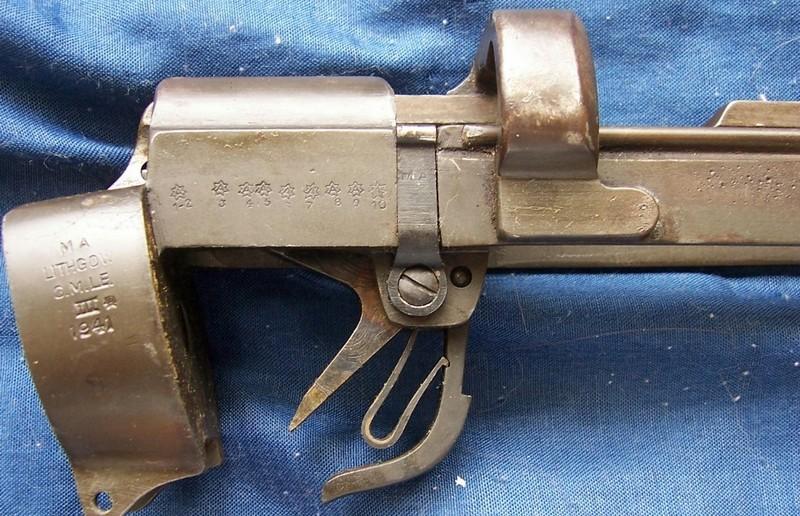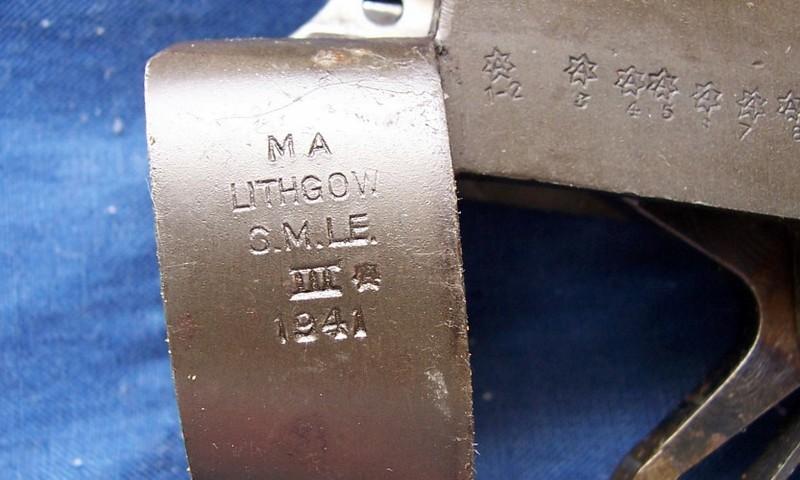-
Legacy Member


Originally Posted by
muffett.2008

Skennerton
does give it the nod, he also states that some unfinished MkIII receivers were set up as MkIII*, the I prefix is all that gives claim to this action being restamped to match a
British
barrel.
To my mind if the only part on a firearm that was salvageable, i.e: damaged receiver, than the complete firearm would have been scrapped.
As the
Australian
system was fully geared up by 1939, the only shortage may have been barrels, were we such obediante slaves to the british system that we would have followed their allready superseded system with a barrel because it was the control part? I doubt it.
It's not a barrel change! every single part (barrel, bolt, trigger guard, sear, safety, nosecap, woodwork, etc) that's fitted to the receiver is of BSA manufacture, all parts that normally carry a s/n are stamped I84115 The Lithgow receiver (the lone Lithgow part) is a MkIII* WITHOUT A CUTOFF SLOT which should not exist for normal Lithgow production.
Not legit because you say so?? I doubt it.
Last edited by 5thBatt; 03-11-2012 at 02:55 PM.
-
-
03-11-2012 02:52 PM
# ADS
Friends and Sponsors

-
Contributing Member


There are allways explanations, only one of them can be correct and, until proven to be accurate, there will always be doubt.
As the only parts you have shown other than the barrel of early vintage is the rear sight, which has the BSA marks which, if considered as inspection marks, cover a time frame from 1861-1960's, or if considered a production mark would be the 1941-1944 time frame, so I can only go on what I see.
Question... did Ian S. physically inspect this firearm? Were checks done to ensure the barrel Knox was fully rounded bar the flat to ensure it had not been altered? Was it possible that actions were sent to Britain , where this change was more likely to have occurred?
, where this change was more likely to have occurred?
-
-
-
Legacy Member


Originally Posted by
muffett.2008

There are allways explanations, only one of them can be correct and, until proven to be accurate, there will always be doubt.
As the only parts you have shown other than the barrel of early vintage is the rear sight, which has the BSA marks which, if considered as inspection marks, cover a time frame from 1861-1960's, or if considered a production mark would be the 1941-1944 time frame, so I can only go on what I see.
Question... did Ian S. physically inspect this firearm? Were checks done to ensure the barrel Knox was fully rounded bar the flat to ensure it had not been altered? Was it possible that actions were sent to
Britain
, where this change was more likely to have occurred?
Yes, Ian Skennerton inspected this rifle in person. I was with 5th Batt at the meeting and have inspected this rifle many times. Every component on the rifle is BSA (with matching serial numbers), with the exception of the receiver (Lithgow
inspected this rifle in person. I was with 5th Batt at the meeting and have inspected this rifle many times. Every component on the rifle is BSA (with matching serial numbers), with the exception of the receiver (Lithgow made), which has been serial numbered with the original BSA number.
made), which has been serial numbered with the original BSA number.
-
-
FREE MEMBER
NO Posting or PM's Allowed

Oh thank you. someone else miss informed me, He had said they never had them. He wasn't from this site.
Was the new receiver thought to be installed in England or Australia
or Australia ? It could have been a favor for someone high up or important that carried the rifle in the great war 20 years before. Weapons have amazing sentimental value. Just an outta of the box thought. Obviously it was something uncommon.
? It could have been a favor for someone high up or important that carried the rifle in the great war 20 years before. Weapons have amazing sentimental value. Just an outta of the box thought. Obviously it was something uncommon.
The Germans would have stamped it that it was in for work. Did the British or Aussies not also do that?
Last edited by JerryB08; 03-11-2012 at 10:32 PM.
-
Legacy Member


Originally Posted by
JerryB08

Oh thank you. someone else miss informed me, He had said they never had them. He wasn't from this site.
Was the new receiver thought to be installed in
England
or
Australia
? It could have been a favor for someone high up or important that carried the rifle in the great war 20 years before. Weapons have amazing sentimental value. Just an outta of the box thought. Obviously it was something uncommon.
The Germans would have stamped it that it was in for work. Did the British or Aussies not also do that?
I think that the rifle was rebuilt by Lithgow, I forgot to add that the receiver is marked NZ and has a sale mark, proving that this was its configuration (BSA/Lithgow mix) during military service. Nobody has talked much about the fact that the receiver has no cutoff slot? Its dated 1939? As a challenge, find me another Lithgow 1939 dated receiver with no slot.
-
-
FREE MEMBER
NO Posting or PM's Allowed

So what is the theory on why there is no slot? just playing devils advocate as I don't know enough about Enfield production to have an opinion. But one could suggest it proves it's either A not a true Lithgow reciever. Which it obviously is or B that it wasn't built that way in 1939 or it WOULD have the slot. I tend to believe it's authentic, as I said playing devils advocate here. Why would Lithgow alter how they are producing recievers in 1939 just for that rifle.
reciever. Which it obviously is or B that it wasn't built that way in 1939 or it WOULD have the slot. I tend to believe it's authentic, as I said playing devils advocate here. Why would Lithgow alter how they are producing recievers in 1939 just for that rifle.
-
Contributing Member


Well I am probably not the first to question this rifle, nor will I be the last.
Whilst there are ever unanswered questions, there will always be someone seeking answers.
Skennerton makes the assumption that this work was done in Australia, my questioning relates to that, and the lack of any Lithgow proof marks.
makes the assumption that this work was done in Australia, my questioning relates to that, and the lack of any Lithgow proof marks.
If what you say is correct and the receiver was damaged and replaced here, I would expect Australian proof or Inspection marks on both the barrel and receiver, however we only have British
proof or Inspection marks on both the barrel and receiver, however we only have British stamps.
stamps.
I would also expect other components to also show some sign of Australian inspection for damage when refitting.
As to the lack of cutout, this is a grey area, the fourth variation receiver adopted in 1916 had the cutoff eliminated.
There seems to be some conflict of opinion between Stratton and Skennerton and without access to factory documents, none of us really know the answer.
This appears to be a MkIII, my understanding was that the asterick was * by this time, not the star, which was a manufacture stamp, the changeover being 1939/1940 from Mk.III to III*, and the Mk III continued to be assembled until 1945. (Stratton)
I'm sure this rifle will continue to draw feedback and the further away we get from it's modification the more comment it will draw, however, my questions remain unanswered.
-
-
Legacy Member

Changeover from MkIII to MkIII* was 1941.
Last edited by Homer; 03-12-2012 at 07:53 AM.
-
-
Legacy Member

I think that is a Lithgow proof on the action.
proof on the action.
-
-
Legacy Member

-
















 PM
PM











